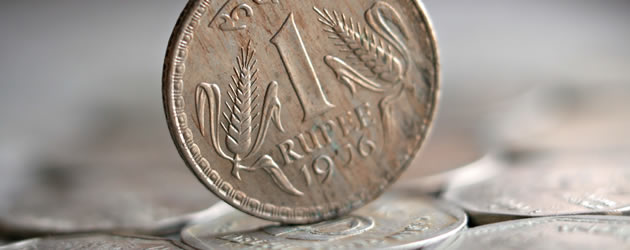 On Tuesday the Pound Sterling to Indian Rupee (GBP/INR) exchange rate was trending in a fairly narrow range.
On Tuesday the Pound Sterling to Indian Rupee (GBP/INR) exchange rate was trending in a fairly narrow range.
A lack of market-moving data kept the pairing restrained while geopolitical tensions had a moderate dampening effect on the appeal of emerging-market assets like the Rupee.
The Indian Rupee (INR) experienced minimal fluctuations after comments issued by Finance Minister Arun Jaitley.
Whilst speaking of the Rupee’s exchange rate Jaitley commented; ‘The Rupee has to be kept at a rate which is real, and this rate clearly is determined by the market itself. The Reserve Bank of India (RBI) itself – which manages this rate – does not target any specific rate. The RBI intervenes only to smoothen the exchange rate volatility and prevent disruptions which take place […] an imbalance between the extent of foreign exchange that we spend and the foreign exchange that comes into the country should not increase to a limit where it cannot be managed. That is what upsets the Rupee-Dollar rate at that time’.
The US Dollar to Indian Rupee exchange rate is currently trading in the region of 60.2350, slightly softer ahead of the publication of the US Consumer Price Index.
The Pound to Indian Rupee exchange rate, meanwhile, was unaffected by the UK’s public finance figures during the European session.
The data showed that the UK’s budget deficit was little changed in June, with net borrowing falling slightly on the year. The figure came in at 11.4 billion in June of 2014, down from 11.5 billion in the same period of the previous year.
Economists had expected a figure of 11.1 billion Pounds.
The Pound was little changed after the data was issued, although economist Howard Archer did note that UK policy makers (and in particular Chancellor of the Exchequer George Osborne) will be ‘fervently hoping that the public finances do improve over the coming months as it would not only reflect well on the government’s stewardship of the economy but also facilitate the offering of a few sweeteners to the electorate just before the May 2015 general election’.
Later in the European session the Confederation of British Industry (CBI) released data showing that UK manufacturing orders and employment growth climbed higher in the second quarter.
The CBI quarterly Industrial Trends Survey showed steady order growth and that firms are positive about the third quarter, although the present geopolitical concerns did have an impact.
According to CBI Director General Katja Hall, ‘The recovery in the manufacturing sector is keeping a good pace. Industry is performing well as orders and hiring are on the up, and investment intentions for the year ahead are looking healthy across the board. It is not all plain sailing however, and there are still risks to the recovery. These include increasing international political instability, and the recent rise in Sterling, which could be weighing on exports. We need to continue to help manufacturers to export their products to high-growth markets across the globe, to give a healthy and sustainable boost to the UK’s recovery.’
While Sterling recovered ground against the Euro over the course of the local session, the British asset remained slightly softer against the Australian Dollar and was little changed against the Rupee.
The Pound Sterling to Indian Rupee (GBP/INR) exchange rate could advance tomorrow following the release of minutes from the latest Bank of England policy meeting.
If the minutes show that any of the nine-member monetary policy committee voted in favour of increasing borrowing costs, the Pound could rally against its peers.
UPDATED 09:45 23 July, 2014
The Pound Sterling to Indian Rupee (GBP/INR) exchange rate was trending in an ever-so-slightly stronger position against as the European session began on Monday.
The pairing was maintaining a stable relationship prior to the BoE minutes release.
Given that the strength of the UK’s ‘overheating’ housing market is one of the main arguments in favour of a BoE rate increase, investors with an interest in the Pound will also be paying attention to the UK’s BBA Loans for House Purchase report.
The report showed that more people than forecast received loans for home purchases in June.
The Pound Sterling to Indian Rupee (GBP/INR) exchange rate achieved a high 102.8400.
UPDATED 24 July, 2014 10:20 GMT
Pound Sterling to Indian Rupee (GBP/INR) Exchange Rate Dips
With emerging-market assets deriving support from the reduced odds of a Federal Reserve rate hike occurring in the near future and the appeal of the Pound being quashed by less-than-impressive meeting minutes, the GBP/INR exchange rate hit a low of 102.0300.
As economic reports for India have been lacking of late movement in the Rupee has largely been driven by global economic developments.
The Pound Sterling to Indian Rupee exchange rate consolidated its modest decline following the release of below-forecast retail sales data for the UK.
Indian Rupee (INR) Exchange Rates
[table width=”100%” colwidth=”50|50|50|50|50″ colalign=”left|left|left|left|left”]
Currency, ,Currency,Rate ,
Pound Sterling, ,Indian Rupee,102.8400,
,Indian Rupee,102.8400,
US Dollar, ,Indian Rupee,60.2500,
,Indian Rupee,60.2500,
Euro, ,Indian Rupee,81.2470,
,Indian Rupee,81.2470,
Australian Dollar, ,Indian Rupee,56.5610,
,Indian Rupee,56.5610,
New Zealand Dollar, ,Indian Rupee,52.2370,
,Indian Rupee,52.2370,
[/table]

Comments are closed.